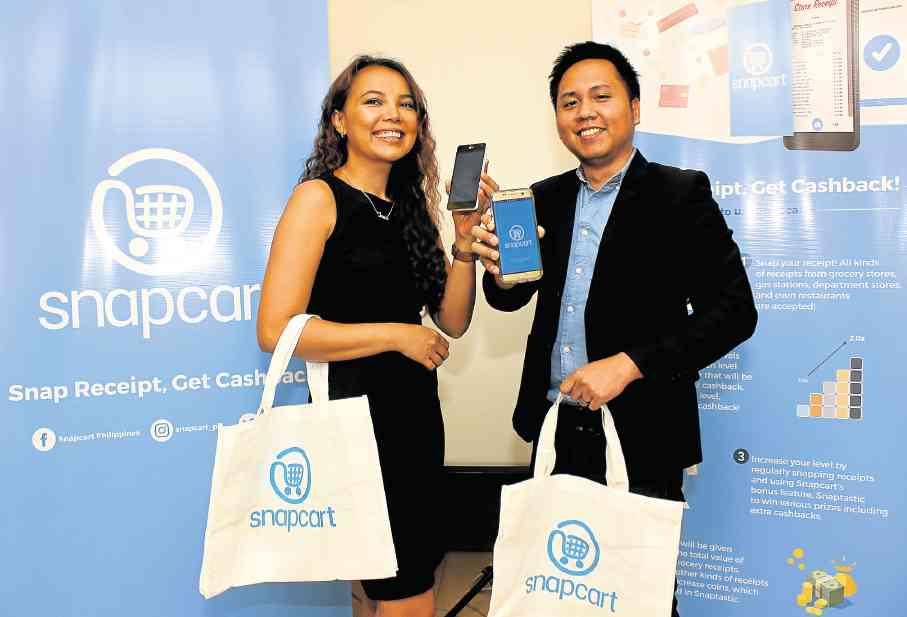Spend more to earn more, startup shows how
In this age when you can produce the most beautiful photos with just a mobile phone, your boring grocery receipt would probably be the last thing you’d want to take a picture of.
But that’s exactly what a startup called Snapcart wants you to do: Using their mobile app, take a snapshot of that grocery, pharmacy, or health and beauty store receipt—and earn back some of the cash you had just spent.
Here’s how it works: Open the app to explore which products have “cashback” prices. Purchase these items at your local grocery, then, through the app, take a photo of your purchase receipt (make sure you fit the whole receipt in the photo so as not to miss any important details). The receipt will be validated within seven working days, and your total cashback balance will be stored.
After reaching a minimum amount, you can opt to cash out your Snapcart balance. The money will be transferred to your preferred bank account, again within seven working days.
The app was developed in Indonesia in 2015 by 39-year-old Mayeth Condicion, 37-year-old Reynazran Royono and 28-year-old Laith Abu Rakty to address what they believed was a “gap” between consumer data available in brick-and-mortar stores and online technology.
Article continues after this advertisementThe three founders all have extensive corporate careers in the retail, fast-moving consumer goods and online commerce industries.
Article continues after this advertisementBefore putting up Snapcart, Condicion was head of market research for Procter & Gamble in Southeast Asia for 17 years; Royono, chief executive officer of the then largest Indonesian commerce site Berniaga.com; and Rakty, vice president of engineering for “startup factory” Ardent Labs.
“Tracking offline commerce and consumer habits still largely involves ‘manual and tedious’ methods such as door-to-door surveys among a few thousand shoppers or among a sample of participating retailers,” Condicion says. “The surveys or audits would take three to four weeks of fieldwork, and by the time data are collated, manually processed and delivered, two to three months would have passed. Knowing that my brand was declining shares or competition has been promoting excessively two to three months ago is less actionable for me.”
Snapcart addresses this issue and helps brands get more real-time information from their consumers, adds Condicion.
“The receipt is a very rich source of information. It allows brands to see what products shoppers are buying, how they are buying it, when and where they bought, what promotions or discounts they got. This allows for real-time reads on market share, price tracking, shopper profiling, or basket analytics— what else are shoppers buying along with their brands,” she says.
Such vital data could help brands, for instance, come up with better campaigns, or gauge which kind of media exposure would be most effective for them.
On the other hand, Snapcart promises consumers nothing less than a rewarding shopping experience, thanks largely to the cashback feature.
There’s also an in-app game called Snaptastic, which allows users to collect coins by filling out surveys, watching videos, taking selfies with their favorite products, or guessing mystery products. These coins may then be used to increase one’s chances of getting cash or shopping vouchers from Snapcart’s over 75 brand partners.
Condicion credits the company’s quick growth to the fact that they are “answering an existing need no one else can fill.”
“[Snapcart] provides value among all stakeholders. Users are happy with the rewards, snap more receipts, get more cash back. Brands get better data and insights, provide more cash backs and other ways to engage. And the virtuous cycle hence starts,” she says.
Snapcart cofounder and chief data officer Mayeth Condicion shares how her startup attracted the right set of investors for the company:
1.) Have a strong idea that scales and sticks. Our products (app and client dashboard) are based on technology that scales automated marketing analytics, machine learning, and OCR (optical character recognition) to provide shopper understanding in a data-sparse environment. We were identified as one of the most disruptive companies in the world (22 of 100) by Disrupt 100 barely one year from launch, among many other recognitions.
2.) Create good networks. Our founders have background in FMCG and market research and analytics, with a strong network of investors and clients and extensive work experience in technology.
3.) Time it right. Our company relies on the strong growth of mobile and modern retail (stores that issue receipts). Two years ago, both Philippines and Indonesia would not have been ready for Snapcart as the penetration of smartphone was still low, and there was a predominance of mom and pop stores which don’t issue receipts (now modern retail accounts for more than half of the market).
4.) Identify which landscape you can compete in. We have the first-mover advantage in providing digitized, real-time shopper data and analytics, disrupting a 100-year-old market research industry that relies on pen and paper.
